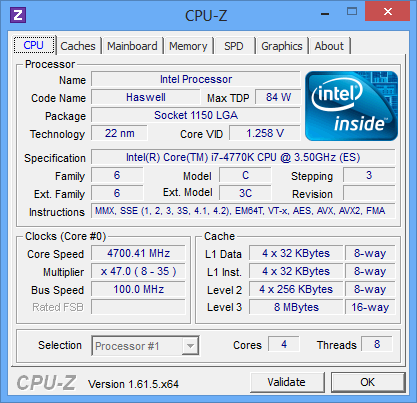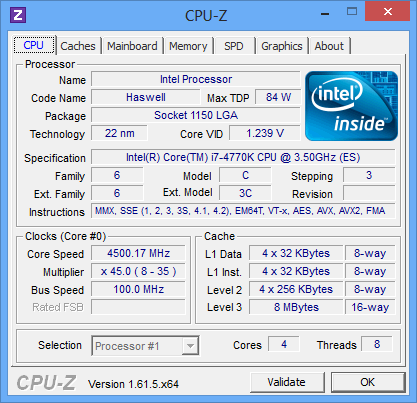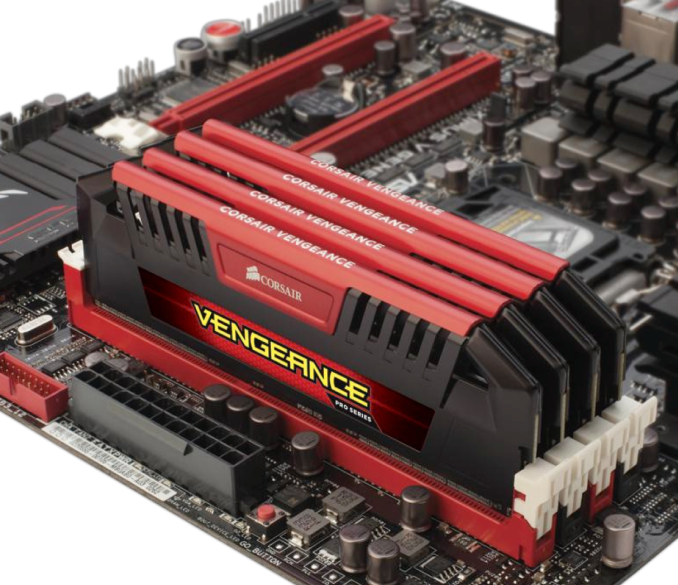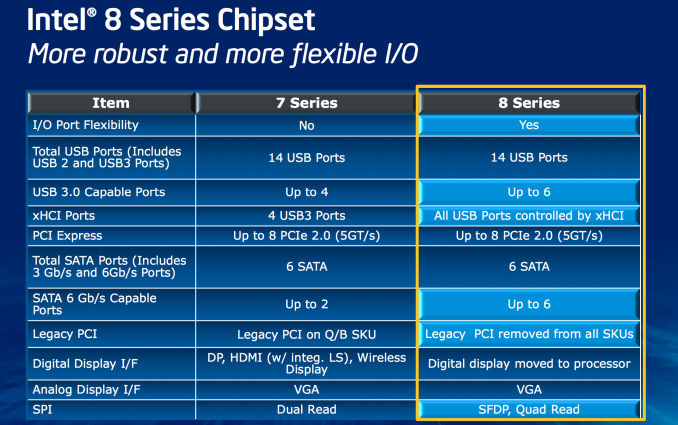The Haswell Review: Intel Core i7-4770K & i5-4670K Tested
by Anand Lal Shimpi on June 1, 2013 10:00 AM ESTMemory
Haswell got an updated memory controller that’s supposed to do a great job of running at very high frequencies. Corsair was kind enough to send over some of its Vengeance Pro memory with factory DDR3-2400 XMP profiles. I have to say, the experience was quite possibly the simplest memory overclocking I’ve ever encountered. Ivy Bridge was pretty decent at higher speeds, but Haswell is a different beast entirely.
Although I used DDR3-2400 for most of my testing, Corsair’s Vengeance Pro line is available in frequencies rated all the way up to 2933MHz.
Platform
Haswell features a new socket (LGA-1150). Fundamental changes to power delivery made it impossible to maintain backwards compatibility with existing LGA-1155 sockets. Alongside the new socket comes Intel’s new 8-series chipsets.
At a high level the 8-series chipsets bring support for up to six SATA 6Gbps and USB 3.0. It’s taken Intel far too long to move beyond two 6Gbps SATA ports, so this is a welcome change. With 8-series Intel also finally got rid of legacy PCI support.
Overclocking
Despite most of the voltage regulation being moved on-package, motherboards still expose all of the same voltage controls that you’re used to from previous platforms. Haswell’s FIVR does increase the thermal footprint of the chip itself, which is why TDPs went up from 77W to 84W at the high-end for LGA-1150 SKUs. Combine higher temperatures under the heatspreader with a more mobile focused chip design, and overclocking is going to depend on yield and luck of the draw more than it has in the past.
Haswell doesn’t change the overclocking limits put in place with Sandy Bridge. All CPUs are frequency locked, however K-series parts ship fully unlocked. A new addition is the ability to adjust BCLK to one of three pre-defined straps (100/125/167MHz). The BCLK adjustment gives you a little more flexibility when overclocking, but you still need a K-SKU to take advantage of the options.


In terms of overclocking success on standard air cooling you should expect anywhere from 4.3GHz - 4.7GHz at somewhere in the 1.2 - 1.35V range. At the higher end of that spectrum you need to be sure to invest in a good cooler as you’re more likely to bump into thermal limits if you’re running on stable settings.

















210 Comments
View All Comments
Ninokuni - Saturday, June 1, 2013 - link
"The new active idle (S0ix) states are not supported by any of the desktop SKUs"Does this mean the whole PSU haswell compatability issue is now irrelevant?
jhoff80 - Saturday, June 1, 2013 - link
I believe that PSU issue was in relation to the C6 and C7 states, not S0ix.smilingcrow - Saturday, June 1, 2013 - link
Correct as desktop PSUs are used with desktop CPUs. :)Egg - Saturday, June 1, 2013 - link
To reiterate owikh84, there appears to be a serious typo in the title - it should be 4670k, not what appears to be a nonexistent 4560k part.RaistlinZ - Saturday, June 1, 2013 - link
This review was a bit more positive than the one at Guru3d. Their numbers show the performance difference being almost nothing. Guess my i7-930 @4Ghz will dredge on for another generation.chizow - Saturday, June 1, 2013 - link
I'd consider it but the IPC gains alone since Nehalem make the upgrade worthwhile, and the rest of the X58 specs are already sagging badly. It still does OK with PCIE bandwidth due to the 40 total PCIE 2.0 lanes, but 20 PCIE 3.0 lanes is equivalent with PCIE 3.0 cards. The main benefit however is running SATA 6G for my SSDs and gaining some USB 3.0 ports for enclosures, etc. They have been bottlenecked for too long on SATA 3G and USB 2.0.I would consider waiting for IVB-E or Haswell-E but Intel always drags their feet and ultimately, these solutions still end up feeling like a half step back from the leading edge mainstream performance parts.
zanon - Saturday, June 1, 2013 - link
Intel's artificial segmentation of some features are more irritating then others, but not including VT-d everywhere really, really sucks. An IOMMU isn't just helpful for virtualization (and virtualization isn't just a "business" feature either), it's critical from a security standpoint if an OS is to prevent DMA attacks via connected devices (and just helping increase stability also). It should be standard, not a segmentation feature.klmccaughey - Monday, June 3, 2013 - link
Yea, I just don't get why they dropped VT-d. Really silly. A lot of power users on the desktop use virtualisation.Chriz - Saturday, June 1, 2013 - link
I'm curious about something. If you say Intel got rid of legacy PCI support in the 8 series chipsets, why am I still seeing PCI slots on these new motherboards being released? Are they using third party controllers for PCI?CajunArson - Saturday, June 1, 2013 - link
"Are they using third party controllers for PCI?"Yes.